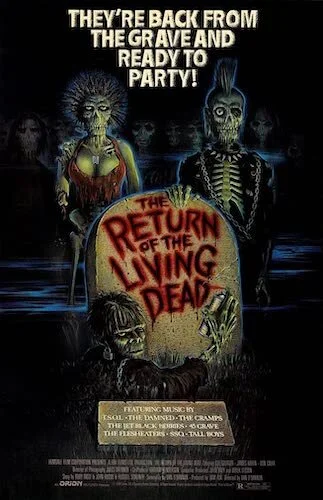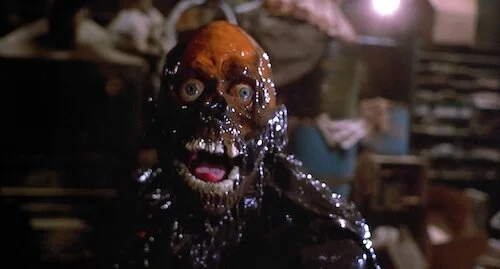The Return of the Living Dead: 31 Days of Horror
For all of October, we will review horror films. Submit your requests here, and you may see your picks selected!
Oddly enough, the origins of The Return of the Living Dead (and the follow up series) are more of a Frankenstein tale than one of zombies. George A. Romero and John Russo, both of whom worked on the classic Night of the Living Dead, began to work on their own ideas after the release of their collaboration. Romero obviously became the king of zombie pictures, but Russo had something to say too. So, Dan O’Bannon was hired to try and help make Russo’s upcoming film unique. O’Bannon was known for his special effects expertise and his script doctoring, and was essentially meant to be the overseer and tidy-upper of Russo’s vision. Ultimately, things changed when Russo abandoned ship, and left O’Bannon as the main man in charge. As to not butcher this opportunity, or get into trouble with those he respected (his zombie filmmakers before him), O’Bannon went hog wild with creating a unique experience: a fun zombie flick that embraced all of the hokeyness, cheesiness, and gore of the cult films that came before.
Enter The Return of the Living Dead: a sister film that is hyper stylized, full of ‘80s fun, and a major prioritization of effects. Deemed a “punk” zombie film, Return boasts a killer soundtrack of all the ear damaging goodness of its time, including songs by The Cramps and T.S.O.L.. This was a zombie film meant to unite viewers, more than a means of creating a sensation of dread; we’ve been there and done that by now, and zombie films weren’t treading any new ground by now. So, why not make a film that purposefully catered to cult audiences (a niche idea that was still slowly growing by this time)? That’s exactly what O’Bannon did. If bad horror films were fun to watch to mock, and great horror classics united certain buffs anyway, why not put both universes together for the ultimate horror fest crammed in an hour and a half?
In 2020, we are still searching for brains for this poor gentlezombie.
The effects are still noteworthy, even with the slim-enough budget. Of course, Return wasn’t going for a sophisticated story or anything, so it only makes sense that all of its effort went into the visual universe of this thing. What I do like, even with everything that I’ve said, is how O’Bannon isn’t really aiming for the impossible task of capturing lightning in a bottle (that landscape of irony that cult films just somehow create), but he really just wanted to do what he loved best. Instead of supervising effects, he could go all out and make some shockingly freaky creations. Instead of cleaning up a script, he would make any liberties he so desired. Instead of tipping his hat off to other zombie pictures, he could do his own thing. Nonetheless, the cult status he may have wished for anyway happened, and a ton of Return films came. The originator — this ‘80s rock ‘n roll zombie jam — is still so much fun. It isn’t saying much, but does it need to? It felt almost like the reanimation of a genre based on reanimation, and it was genuinely enjoyable whilst doing so.
Andreas Babiolakis has a Masters degree in Film and Photography Preservation and Collections Management from Ryerson University, as well as a Bachelors degree in Cinema Studies from York University. His favourite times of year are the Criterion Collection flash sales and the annual Toronto International Film Festival.






